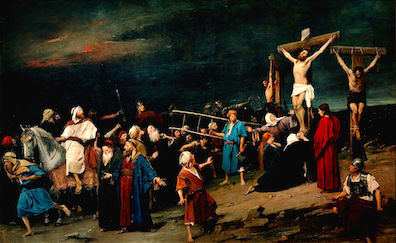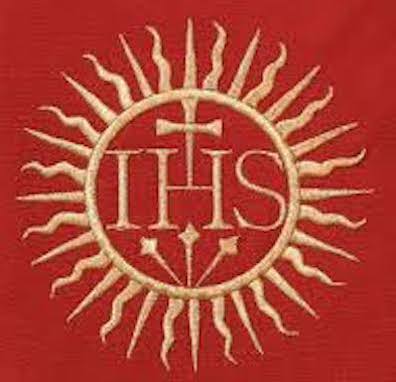Matthew's gospel records that, after Pontius Pilate assented
to the Jews' demand that Jesus be crucified, the Roman
soldiers mocked and tormented the purported Messiah by putting
a crown of thorns on him: "And when they had platted a crown
of thorns, they put it upon his head, and a reed in his right
hand: and they bowed the knee before him, and mocked him,
saying, Hail, King of the Jews. And they spit upon him, and
took the reed, and smote him on the head" (Matthew 27:29). The
sharp thorns pressed into Christ's scalp anticipate the nails
driven into his hands and feet on Golgotha, and the two
tortures have become iconographically combined in the common
Christian image of a cross wreathed with a crown of thorns.
In John's gospel, the mock crowning occurs after Pilate
examines Jesus but before he gives the crowd of angry Jews
what they want. "Pilate therefore went forth again, and saith
unto them, Behold, I bring him forth to you, that you may know
that I find no fault in him. Then came Jesus forth, wearing
the crown of thorns, and the purple robe. And Pilate saith
unto them, Behold the man! When the chief priests
therefore and officers saw him, they cried out, saying,
Crucify him, crucify him" (19:4-6). "Behold the man" in the
King James English corresponds to a Latin phrase in the
Vulgate Bible, "Ecce homo."
Late in his prolific career Mihály Munkácsy, a Hungarian
artist who died in 1900, painted a trilogy of immense canvases
(each more than 20 feet, or 6 meters, long) titled Christ
in Front of Pilate (1881), Golgotha (1884), and
Ecce Homo (1896). The paintings quickly became famous
and went on tour in Europe and America. In 1899 Ecce Homo
was displayed at the Royal Hibernian Academy in Abbey
Street Lower, where a 17-year-old Joyce was moved to write an
essay about it.
Anticipating his lecture on
"Drama and Life" in the following year, the young Joyce
saw Munkácsy's painting as a powerful "drama," by which he
meant a work in any artistic medium that conveys eternal human
passions and aspirations. His analysis focused on the states
of mind visible in the dozens of faces and postures
represented in the painting, seeing it as "a frightfully real
presentment of all the baser passions of humanity, in both
sexes, in every gradation, raised and lashed into a demoniac
carnival" (Critical Writings, 35). Even when painting
Jesus and Mary, Joyce argued, Munkácsy eschewed traditional
static depictions of holiness to give piercing renditions of
ordinary, suffering humanity.
Ecce Homo includes some of the details mentioned in
Matthew 27 and John 19, including the reed in Jesus' hands. Golgotha,
like many other paintings of the Crucifixion, includes the
letters INRI at the top of Jesus' cross. Bloom thinks of these
as he looks at the priest putting away the communion cup after
mass: "Letters on his back: I.N.R.I? No: I.H.S. Molly told
me one time I asked her. I have sinned: or no: I have
suffered, it is. And the other one? Iron nails ran in."
The acronym he is looking for is another traditional detail
of Christ's passion, said to have been placed at the top of
his cross by the Roman soldiers, which repeats the mockery of
the crown: Iesus Nazarenus, Rex Iudaeorum (Jesus of
Nazareth, King of the Jews). Bloom recaptures the spirit of
mockery with a joking alternative that he has heard somewhere:
Iron Nails Ran In. In Lestrygonians he is still
thinking of how appallingly bloody Christian objects of
devotion are, and the phrase recurs: "Our Saviour. Wake up
in the dead of night and see him on the wall, hanging.
Pepper’s ghost idea. Iron Nails Ran In."
But the letters on the priest's surplice are actually IHS.
About these Bloom is wildly mistaken (and his teacher Molly
also, it seems), but even Catholics are given different
accounts of their meaning. In one version, they too refer to
the cross: before the emperor Constantine went into battle
behind an image of the cross, an angel told him that he would
conquer In Hoc Signo (In This Sign). Another gloss of
the letters is Iesus Hominum Salvator (Jesus, Savior
of Mankind). But both ancient Latin phrases arose as false
constructions of the Greek ΙΗΣ, a contracted form of IHΣΟΥΣ
(Jesus). The Bloom family version lives on in Circe: "I
have sinned, I have suff..."




